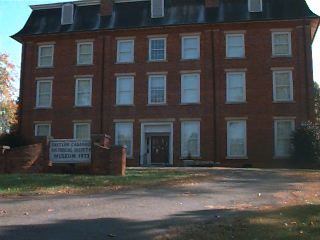Lutheran Schools of Mount Pleasant
 By the middle of the nineteenth century, the North Carolina Synod of the Lutheran Church had become concerned about the lack of schools that could prepare the young men of North Carolina for a career in the ministry. At a special meeting of the Lutheran Synod in Concord on 21 July 1852, Western Carolina Male Academy was established at nearby Mount Pleasant. Col. William A. Weddington was awarded a contract to construct a three-story brick building on a tract of 16-plus acres purchased for $81.25 from Matthias Barrier. Weddington also built a home on the site for the school's first president (and first professor), William Gerhardt, who was inaugurated on 24 May 1853. The school prospered to the extent that in 1859 a charter was secured from the General Assembly converting the academy into North Carolina College. Mount Pleasant itself was incorporated by an act of the same legislature. Two additional buildings, Philaethian and Pi Sigma Phi Literary Halls, were erected on campus in 1859. All students over age 14 were required to join one of those two societies, which stressed public speaking and debating. Classes were interrupted in 1861 by the Civil War and did not resume until 1867.
By the middle of the nineteenth century, the North Carolina Synod of the Lutheran Church had become concerned about the lack of schools that could prepare the young men of North Carolina for a career in the ministry. At a special meeting of the Lutheran Synod in Concord on 21 July 1852, Western Carolina Male Academy was established at nearby Mount Pleasant. Col. William A. Weddington was awarded a contract to construct a three-story brick building on a tract of 16-plus acres purchased for $81.25 from Matthias Barrier. Weddington also built a home on the site for the school's first president (and first professor), William Gerhardt, who was inaugurated on 24 May 1853. The school prospered to the extent that in 1859 a charter was secured from the General Assembly converting the academy into North Carolina College. Mount Pleasant itself was incorporated by an act of the same legislature. Two additional buildings, Philaethian and Pi Sigma Phi Literary Halls, were erected on campus in 1859. All students over age 14 were required to join one of those two societies, which stressed public speaking and debating. Classes were interrupted in 1861 by the Civil War and did not resume until 1867.
The first postwar class graduated in 1871. During the 1873-74 school year, there were 115 students enrolled-95 students of high school age at the academy level and 20 at the college level. A Theological Department was added for aspiring ministers unable to attend a regular seminary. A Commercial Department was added in the 1890s. At its zenith, the college offered the B.A., B.S., and Ph.D. degrees. During the next 29 years, 66 men graduated from North Carolina College, and most entered the learned professions. At least 28 of them became Lutheran ministers. By 1900 enrollment at North Carolina College had dropped to 56 students, and financial problems worsened. The class of 1901 was the last to graduate from the college.
In 1859 a Lutheran school for young women was established in Mount Pleasant, with Mrs. D. H. Bittle, the wife of a Lutheran minister, as principal. Her husband was then serving as president of North Carolina College. The school was first known as Mount Pleasant Female Seminary. In 1892 school officials changed its name to Mont Amoena Seminary, using the Latin version of the town's name. In 1868 G. D. Bernheim, who was then in charge of the school, offered to transfer it to the synod on favorable terms. The transfer was completed in 1869, and the first board of trustees of the school was elected. Mont Amoena had 112 students by 1897.
In 1903 a school named Mount Pleasant Collegiate Institute began operating on the campus of the then-defunct North Carolina College. The Lutheran Synod resumed sponsorship of the institute, which retained the original purpose of preparing young men for the seminary and other professional careers. During the 1903-4 school year, 3 teachers taught 52 students at the institute; by 1923 there were 8 teachers, 173 students, and some 200 alumni.
At the Mount Pleasant Female Seminary, the financial situation was more stable. The seminary burned on 30 Nov. 1911, but a large, new brick structure soon replaced the burned frame building. The school was quite successful for about half a century, but after a time it became increasingly difficult for it to compete with newer facilities such as Elizabeth College in Charlotte. Public high schools also began duplicating the work of the seminary, and Mont Amoena finally closed its doors in 1927. Thereafter, the first female students were allowed on the campus of Mount Pleasant Collegiate Institute as day students.
Prior to the merger of the North Carolina and Tennessee Lutheran Synods in 1921, the Mount Pleasant Collegiate Institute could depend on some funding from the synod and from individual Lutheran congregations. After the merger, however, it became even more difficult to obtain adequate funding, as the institute had to compete with more successful institutions such as Lenoir-Rhyne College. Fees and tuition alone were simply not adequate to fund the school's continued operation. Economic necessity finally forced the school's permanent closing in 1935.
References:
Raymond M. Bost and Jeff L. Norris, All One Body: The Story of the North Carolina Lutheran Synod, 1803-1993 (1994).
Jacob L. Morgan, Bachman S. Brown Jr., and John Hall, eds., History of the Lutheran Church in North Carolina (1953).
Additional Resources:
Beyond Books and Buildings: Chronological List of Colleges & Universities: http://www.lib.unc.edu/highered/list.html
NC Historical Marker: https://www.ncdcr.gov/about/history/division-historical-resources/nc-highway-historical-marker-program/
Mount Pleasant Collegiate Institute Yearbooks: https://lib.digitalnc.org/search?ln=en&p=691:%22Mount+Pleasant+Collegiate+Institute%22%20AND%20655:%22Yearbooks%22&sf=year&so=a
Image Credit:
Mount Pleasant Collegiate Institute, NC Historical Marker L-65. Image courtesy of the North Carolina Office of Archives & History. Available from https://www.ncdcr.gov/about/history/division-historical-resources/nc-highway-historical-marker-program/ (accessed June 7, 2012).
1 January 2006 | Horton, Clarence E., Jr.